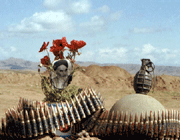Beit-al-MoqaddaS Offensive Operation (Karbala third Operational plan) (April 30th, 1982)

Iranian Khuzestan operational region, more than 300 kilometers wide, is divided into three battlefields: northern part which is located in the west of Dezful and Shush librated in Fath-al-Mobin (second Karbala) operation. Middle front including fighting region in Sasangerd and Bostan liberated in successful Tariq-al-Qods (first Karbala) operation. The third one called southern front included west of Ahwaz and north of Khorramshahr which despite the attempt made to liberate it remained occupied. For this purpose Nasr and Tavakkol operations were performed by Iranian forces on January 5th, 1981 and January 10th 1981 respectively. Waterlogged plan which was implemented by Khuzestan electric & water supply organization under the supervision of armed forces in Karkheh koor (South of Hamidiyeh-Susangerd) and south west of Ahwaz was taken into consideration and put into use in Beit-al-Moqaddas operation plan.
This plan caused Iraq to be stationed in inappropriate positions and the threat and collapse of Ahwaz through Sasangerd axis was neutralized. Although this plan was done in favor of Iranian forces in southwest of Ahwaz, Iraqis also exploited it and reinforced their positions against Iranian probable attacks. Bcit-al-Moqaddas operation planning started under the title of Karbala operations series and the third Karbala was launched on March 29th, 1982 immediately after Fath-al-Mobin operation.
The major concept was to liberate the third strategic area before Iraqi aggressors could recover from Fath-al-Mobin blow and according to military term Beit-al-Moqaddas operation was an exploitation of success for Fath-al-Mobin operation. The main reasons for Beit-al-Moqaddas operation were battle continuity against enemy, threatening Basreh, reducing the enemy’s combat power, liberating Khorramshahr and distancing Ahwaz from the enemy’s artillery fire range. Furthermore, political considerations in connection with displaying instability of Iraqi regime, forcing Iraq to accept Iran’s conditions for ending the war, reducing the pressure resulted from the war immigrant’s difficulties inside the country and preparing the ground for agricultural activities in Khuzestan fertile regions had been the focus of attention. This operation was planned and conducted jointly by Army and Islamic Revolutionary Gourd Corps. The operating headquarter under the title of Karbala headquarter conducted the operation with the collaboration of four headquarters including Qods, Nasr, Fath and Fajr containing seven divisions and five independent brigades from Army and Islamic Revolutionary Guard Corps with the code of " O AIi, the son of Abitaleb (PbUH) .Based on the operational plan the action had to be accomplished at four stages as follows:
1-Qods headquarter was assigned to make an attack from the north and Fath & Nasr headquarters were to implement the operation of crossing Karun River and secure the beachhead in the west of Karun.
2- Stabilizing the occupied beachhead and extending the attack to secure the border.
3-Securing the border, liberating Khorramshahr and extending the battle for capturing Nashveh Bridge at order.
4 Securing the cast bank of Arvand at order.
The main reasons for friendly forces failure to reach Basreh, Tanumeh and operation's standstill after Khorramshahr liberation included selection of tactical withdrawal by the enemy from south of Hoveizeh and Talaiyeh & Kushk's northern areas which helped Iraqis reserve a considerable man power to defend Basreh and keep them from being destroyed. The other reason was the elongation of operation for 25 days of relentless battle culminating in combat power reduction and fatigue among fighting units. Furthermore, no success was guaranteed. ln this operation major general Khosrotash bravely fought the enemy and suffered martyrdom and another Iranian hero major general`Hassan Hadavandmirz``aee a day before Khorramshahr liberation was wounded and taken captive in Shalamcheh region and after eight years of captivity suffered martyrdom in Iraq.
Result:
- With the changes made in the conduction of operation, 5400 kilometers of the holy land of Islamic Republic of Iran were liberated and Khorramshar was ultimately freed after 19 months of occupation. Borderlines strectching from shalamcheh to north of Talaiyeh were secured. Hamid barracks and Ahwaz- Khorramshar axis were also seized by friendly forces and Hoveizeh city was liberated.
-Two Iraqi divisions were thoroughly destroyed and six division suffered serious damages from %20 up to %60.
- More than 16000 soldiers were either killed or wounded and 17499 others were taken captive.
-550 tanks and personnel carriers, 50 vehicles, tens of guns and a large quantity of different weaponry and ammunition were destroyed and 53 fighters and three choppers were shot down. Beit-al-Moghaddas operation is considered as the most extensive, effective and largest action made by Iran during the war. After the liberation of Khorramshar an atmosphere was created to terminate the war, but Iraq at the command of global hegemony didn’t capitulate to Iranian conditions and this opportunity was aborted. The battle for the liberation of occupied lands and penetration into Iraqi territory continued.
Source:
Atlas of Unforgettable Battles (Ground forces operations in eight years of holy defense)
Compilation: Staff Colonel Mojtaba Jafari
Other links:
Quch-Soltan’s defensive operation (April 16th, 1981)
Bazideraz offensive operation (1) (April22nd, 1981)
Tappeh Cheshmeh offensive operation (2) (May 1st, 1981)
Allah-o-Akbar (Kheibar) offensive operation (May 21st, 1981)
Hills of Angoosh offensive operation (May21st, 1981)